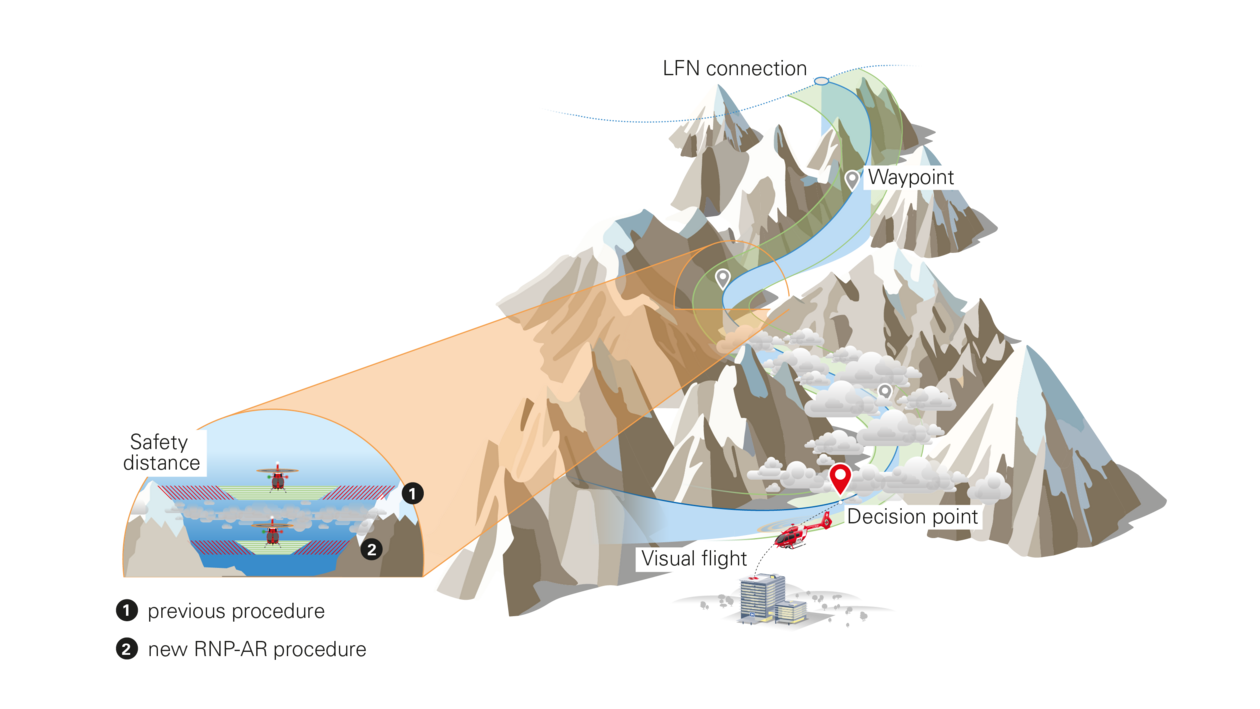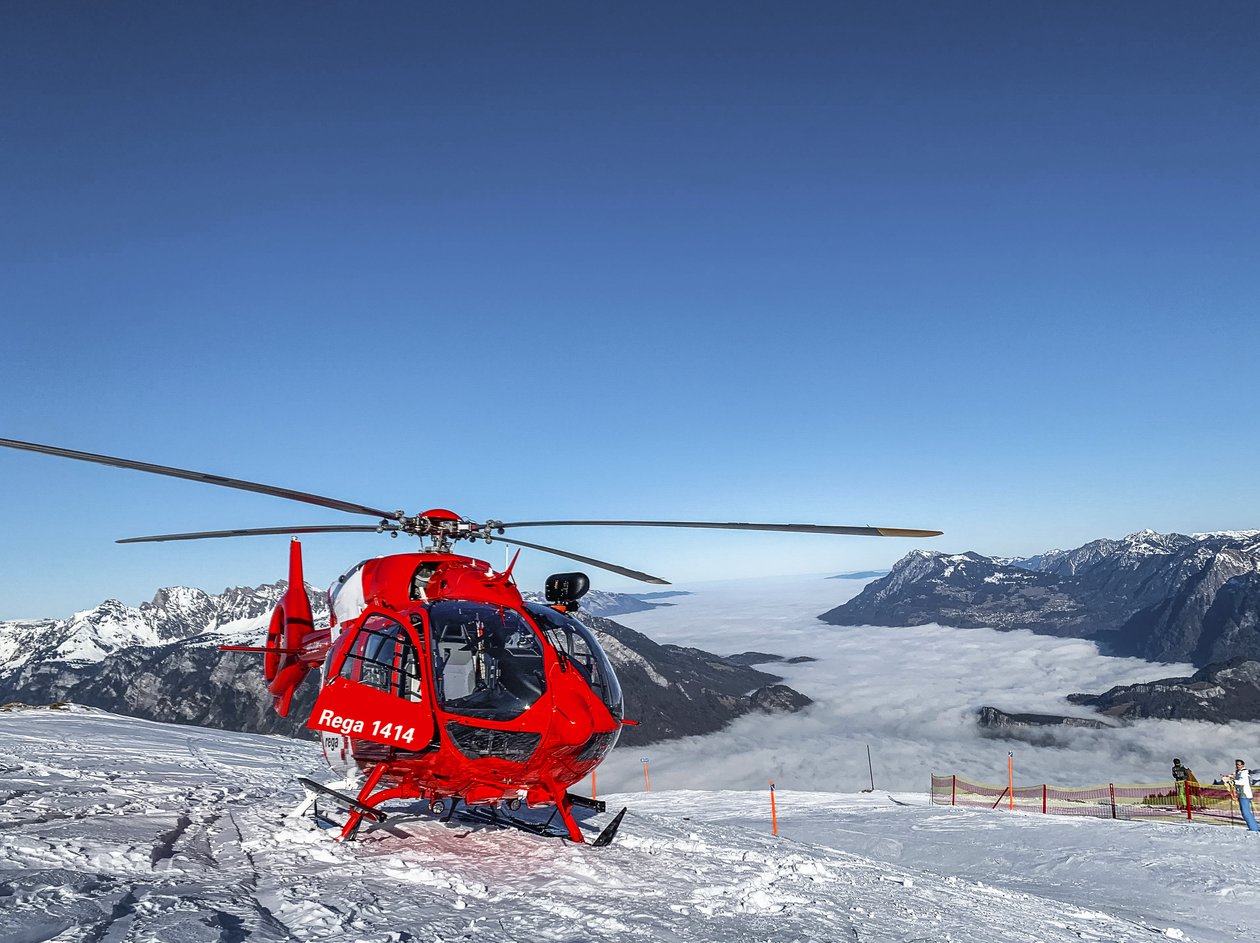The invisible road network in the clouds
The LFN routes connect different regions in Switzerland, similarly to a network of motorways. “Approaches and departures” on this network take place at Rega bases, airports and hospitals. “Departures” undertaken so far, such as from the Inselspital University Hospital in Berne or the University Hospital in Zurich, were developed according to the LPV Point-in-Space procedure. These approach methods involve satellite-aided, vertical and horizontal course guidance to a specified point before the landing site where the pilot decides either to land under visual flight conditions or to follow the pre-defined alternative route on autopilot. The routes designed according to this concept require a lot of space and distance from obstacles. Furthermore, there can be no turns in the approach flight, for example to adapt the route to the topography.
New challenges in the Alpine valleys
The “departures” from central hospitals are all in the lowland area of Switzerland, where the flat topography allows the wide approach routes to be designed at sufficient distance from the terrain. In the Alpine valleys, however, this is not so. In areas such as Engadin, Davos or the Bernese Oberland, the topog-raphy around the hospitals precludes the use of conventional IFR approach procedures. As far as Rega was concerned, the solution to this problem had long been evident: what was needed was an even more accurate IFR procedure, of the kind already occasionally employed in fixed-wing aviation. RNP-AR (Required Navigation Performance Authorisation Required) permits extremely accurate route guidance, fully tailored to the terrain, and enables “narrower” routes to be developed with tighter turning radii and steeper descent profiles. This means Rega can navigate according to instrument flight rules even in the challenging topography of Alpine valleys, where obstacles have to be circumnavigated and the decision point should be as close as possible to, and as low as possible over the hospital: much like a narrow mountain pass road in challenging terrain where is no room for a wide motorway.
Ultra-precise navigation
These “tight” air corridors place the highest demands on the navigational precision of the helicopter and its navigation and autopilot systems. This is not so dissimilar to self-driving cars: a wide, straight motorway places fewer demands on navigational precision and autopilot than if the vehicle has to autonomously navigate a tight pass with a narrow road and hairpin bends. The challenge of putting this idea into practice has shades of the famous “chicken & egg” scenario: since no helicopters were yet authorised for an RNP-AR rule anywhere in the world, no RNP-AR rule could be approved. And without a rule, no helicopters could be certified.
Rega takes the initiative
Rega, however, was not going to settle for that: having some time ago set itself the goal of using this new rule, it brought together around one table the various parties whose input is essential in establishing the criteria for certification. The ARIOS (Advanced Rotorcraft IFR Operations in Switzerland) project involved Rega, along with FOCA and the European Union Aviation Safety Agency EASA, rule designers, helicopter manufacturers and other experts, joining forces to develop the criteria for RNP-AR helicopter rules. In recent years, Rega has conducted numerous measurement flights, drawn up risk calculations and designed and tested a new instrument flight route for Interlaken hospital and the regional airport in Samedan. On the back of these, the list of criteria has been adapted and confirmed based on the measurement and test flights. Finally, Rega was able to submit to FOCA the evidence needed to approve the rule at Interlaken hospital.
Interlaken becomes the first RNP-AR route
The Interlaken region was the obvious choice as the first place to deploy RNP-AR. Rega’s Widerswil base, which is just a few minutes’ flying time from Interlaken hospital, undertakes more missions than any other mountain base. In the challenging topography around Interlaken, with its narrow valleys and high peaks, the rule’s precision really comes into its own. FOCA reviewed the documents and, last July, authorised the rule. The foundations are thus now in place for the Low Flight Network to be further expanded and, in particular, for hospitals in the Alpine valleys to be added to it.



